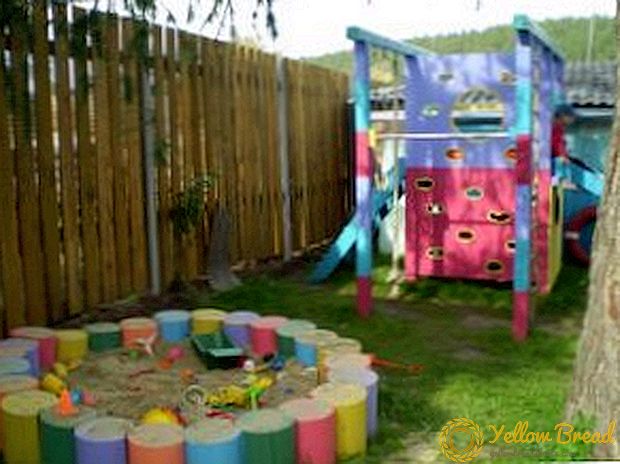 Beekeeping does not stand still and periodically introduces some new developments that allow the bees to create more comfortable conditions for work and development, and the apiary owner, at the same time, simplify and reduce the daily chores. One of the interesting developments is the arrangement of the pavilion for bees of the Berendey type. If you are interested in what it is and how to make this design yourself, we suggest reading our article.
Beekeeping does not stand still and periodically introduces some new developments that allow the bees to create more comfortable conditions for work and development, and the apiary owner, at the same time, simplify and reduce the daily chores. One of the interesting developments is the arrangement of the pavilion for bees of the Berendey type. If you are interested in what it is and how to make this design yourself, we suggest reading our article.
- Cassette Pavilion
- Pavilion "Berendey" do it yourself
- Material and tools
- Manufacturing process
- Advantages and disadvantages
Cassette Pavilion
The cassette pavilion is a small mobile unit with 10-40 compartments divided by plywood partitions in which bee families live. This unit can be easily transported, bringing closer to the honey plants.  It can have various sizes and designs. Its internal structure can be compared with a dresser, where there is a separate hive in each “drawer”.
It can have various sizes and designs. Its internal structure can be compared with a dresser, where there is a separate hive in each “drawer”.
Best of all, if the pavilion is equipped with wheels, which will make it easier for the apiary to transport him to the source a bribe to increase the volume of honey produced.

Pavilions are made or purchased for several purposes:
- optimization of space in the apiary (you can compare how much space on the site, for example, will take 10 beehives or one bee-pavilion);
- increase in the amount of honey collected per season;
- use not only for honey harvesting, but also as a pollinator, apiary for sectional harvesting of honey, royal jelly, creating cuttings.
The Berendei construction has earned the most positive feedback. It is considered the most effective, convenient and promising.
The cost of one pavilion for 48 families is about 3-4,5 thousand dollars in the used version and up to 9 thousand dollars for a new design.

Pavilion "Berendey" do it yourself
It’s not easy to make a pavilion. Of course, you have to tinker a bit. Begin with the development of a drawing. With the finished drawing on hand, it will be possible to clearly define what tools are needed and what the structure will look like in the finished form.
In the drawing should be presented:
- finished pavilion dimensions;
- the order of placement, the size of the working and domestic premises;
- internal heating equipment;
- interior lighting equipment;
- arrangement of ventilation;
- availability of storage compartment for inventory and clothing.

Material and tools
In order to get a good cassette hive, you must have at least minimal skills in working with wood, metal, and the following tools:
- shuropovert;
- nails;
- self-tapping screws;
- hammer;
- pliers;
- knife;
- saw;
- plane;
- levels.
- wooden boards and bars (or metal pipes);
- ruberoid;
- Styrofoam;
- tol;
- soft fiber board;
- slate or roofing aluminum;
- grid of metal or cardboard (cell size 2.5-3 mm);
- cap hooks;
- plexiglass or film.
- trailer (great for trucks ZIL and IF);
- welding machine;
- jack.

Manufacturing process
Pavilion "Berendey" make three types: 16, 32 and 48 families.
The process of making a pavilion can be divided into three stages:
- frame making;
- arrangement of viscera;
- manufacture of cassettes.
The frame is made of wooden bars (metal rods), which will later be sheathed with boards, or metal boxes. When sheeting boards should avoid the formation of cracks.
For tightness, the top of the boards needs to be covered with plywood and roofing felt. The walls and the floor must be made multilayered with the obligatory use of insulation that will not allow the pavilion to cool down much in the winter and to overheat in the summer. The inner lining will be made of 3 mm hardboard.
The roof is made of roofing material or metal profile. It can be folding. It will need to make hatches or windows for the penetration of daylight. Also, it will need to be insulated from external noise. For this purpose, best suited foam, which is placed under the roof.
In the case it is necessary to think over and make two entrance doors (one - in the work area, the other - in the back room), as well as the tap hole.  If the pavilion is located on an elevation (for example, on a trailer, telescopic racks), then it will need to be equipped with a sliding metal ladder, along which it will be possible to climb and enter the cassette beehive.
If the pavilion is located on an elevation (for example, on a trailer, telescopic racks), then it will need to be equipped with a sliding metal ladder, along which it will be possible to climb and enter the cassette beehive.
The frame of each section is made of several layers, with foam, which is placed between the plywood. In one section there will be eight risers with internal partitions. Each riser is designed for nine cassettes for two families.
The risers are equipped with one door, which provides access to two cassettes. Thus, there should be five doors.
They must be closed on folding hooks and be made of transparent materials (Plexiglas, thick film) so that you can inspect the condition of the family without disturbing it. Also in them it is necessary to do four air vents, which are covered with a grid.  Troughs are located on each of the doors, at the same time through them air circulates.
Troughs are located on each of the doors, at the same time through them air circulates.
The lower part of each standpipe should be equipped with a pollen trap and antivarotomy mesh.
At the ninth cassette level, two cores can be arranged.
Risers are painted in different colors so that families do not mix with each other.
After the construction of the frame and compartments can proceed to the arrangement of cassettes. Cassettes are boxes, the dimensions of which can be determined by the beekeeper himself.  For example, in the video we propose is a box 29.5 cm high, 46 cm long and 36 cm wide.
For example, in the video we propose is a box 29.5 cm high, 46 cm long and 36 cm wide.
Cassettes should be made of strong and durable materials - wood, fiberboard, plywood will do.
On the front wall of each cassette should be located tap hole. The number of frames in the cassettes is determined for each design individually.
The gap between the cassettes should be 1.5 cm.
Cassettes are mounted either on the bolts or on the slats-stoppers.
The pavilion should have a stand or folding table for the extracted cassettes.
Advantages and disadvantages
Keeping bees in a cassette pavilion has both advantages and disadvantages. Among the advantages worth noting:
- mobility and the possibility of transportation closer to honey plants;
- the ability to work with bees in any weather;
- ease and simplicity of the content and work in it;
- versatility - the possibility of using in the form of a pollinating honey apiary and a specialized apiary for collecting royal jelly and producing cuttings;
- increase in the amount of collected honey and honeycomb;
- the ability to maintain optimal temperature and no need for insulation;
- simplification of the feeding procedure;
- simplify the process of building families;
- convenience in carrying out prevention of diseases;
- increased activity of building families.

Among the cons, we note the following:
- tightness at work;
- proximity to families leads to confusion and causes some problems with the content of insects;
- fire insecurity - as a rule, cassette hives are made of highly flammable materials.
Beenday Bee Pavilion is an excellent design that allows you to successfully keep bees in small areas and on an industrial scale.
Keeping bees in such conditions has several advantages and greatly simplifies the work of the beekeeper.  When making a cassette pavilion with their own hands, the owner of the apiary can think through every detail and make the design most convenient for his work with bees.
When making a cassette pavilion with their own hands, the owner of the apiary can think through every detail and make the design most convenient for his work with bees.
According to experienced beekeepers, a correctly made "Berendey" allows increasing the efficiency of the apiary by 30-70%. Its construction, with all the tools and materials, as well as additional workers, takes about two days.






